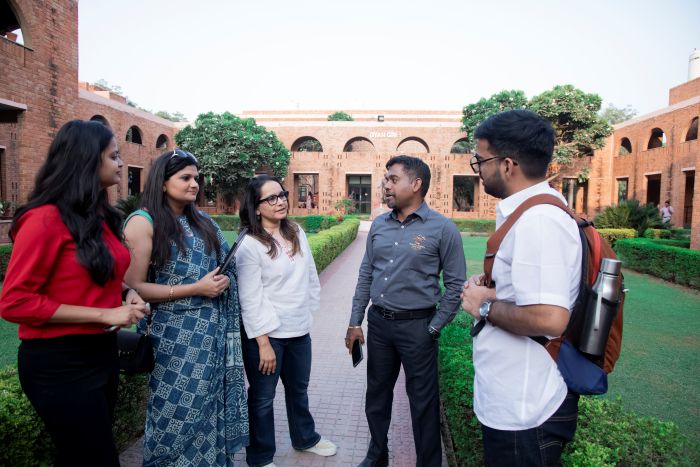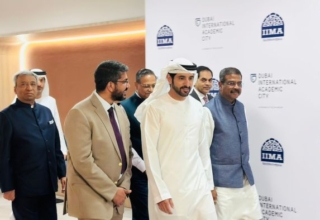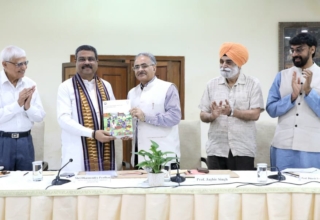The latest Annual Status of Education Report (ASER), based on the largest annual household survey of children in rural India that focuses on the status of schooling and basic learning conducted by Mumbai-based Pratham (a voluntary organization) was released on January 13 in New Delhi. ASER 2014 survey got conducted by local organizations and institutions in each district and reached 16,497 villages in 577 districts. Aabout 570,000 children in the age group 3-16 were surveyed in over 340,000 households.
Every year, ASER finds out whether children in rural India go to school, whether they can read simple text and whether they can do basic arithmetic. Since the implementation of the RTE Act in 2010, school visits in ASER have included indicators of compliance with those norms and standards specified in the Act that are easy to measure. In 2014, ASER visited 15,206 government schools across rural India.
According to the findings, India is close to universal enrolment for the age group 6-14, with the percentage of children enrolled in school at 96% or above for six years in a row.The proportion of children currently not in school remains at 3.3%. In some states the proportion of girls (age group 11-14) out of school remains greater than 8%. These states are Rajasthan (12.1%) and Uttar Pradesh (9.2%). Although enrolment levels are very high for the age group covered by the Right to Education Act (i.e. 6 to 14 years), the proportion of 15 to 16 year olds not enrolled in school is substantial. Nationally, for rural areas, 15.9% of boys and 17.3% of girls in this age group are currently out of school.
Among other results, the proportion of children enrolled in private schools has increased slightly from last year. In 2014, 30.8% of all 6-14 year old children in rural India are enrolled in private schools. This number is up slightly from 29% in 2013. As in previous years, in each age group, a higher proportion of boys go to private schools as compared to girls. In 2014, in the age group 7-10 years, 35.6% of boys are enrolled in private schools as compared with 27.7% of girls. For the age group of 11-14 years, 33.5% of boys are in private schools as compared to 25.9% of girls. Compared to similar figures in 2013, there has been an increase in private school enrolment in almost all states. The only exceptions to this are Gujarat, Maharashtra, Uttarakhand, Nagaland and Kerala.
Five states in India now have private school enrolment rates in the elementary stage that are greater than 50%. These are Manipur (73.3%), Kerala (62.2%), Haryana (54.2%), Uttar Pradesh (51.7%), and Meghalaya (51.7%).
Reading levels remain low and unchanged. Overall, the situation with basic reading continues to be extremely disheartening in India. In 2014, in Std III, only a fourth of all children can read a Std II text
fluently. This number rises to just under half in Std V. Even in Std VIII, close to 75% children can read Std II level text (which implies that 25% still cannot). Some very small improvements in reading are visible in the last few years. For example, the proportion of Std V children who can at least read a Std II level text has inched upwards from 46.8% in 2012 to 47% in 2013 and to 48.1% in 2014.
38.7% of Std III children could read at least a Std I level text in 2012. This number is slightly higher at 40.2% in 2014. In some states, reading levels have improved since last year. For example, in 2014
a higher proportion of children in Std V in Himachal Pradesh, Haryana, Bihar, Odisha and Karnataka can at least read Std II level text than was the case last year. Tamil Nadu shows major gains in reading over last year for Std V.
Looking at trends over time, in many states the reading status of children is largely unchanged. However in some states, like Bihar, Assam, Jharkhand, Chhattisgarh, Madhya Pradesh and Maharashtra there are visible declines in reading levels over the last 5-6 years.
Math continues to be a serious and major source of concern. The All India (rural) figures for basic arithmetic have remained virtually unchanged over the last few years. In 2012, 26.3% of Std III children could do a two digit subtraction. This number is at 25.3% in 2014. For Std V children, the ability to do division has increased slightly from 24.8% in 2012 to 26.1% in 2014.
There are other trends which are quite worrying. For example, the percentage of children in Std II who still cannot recognize numbers up to 9 has increased over time, from 11.3% in 2009 to 19.5% in 2014.
Similarly, the ability to do division among Std VIII students has been dropping since 2010. The proportion of Std VIII students who could correctly do a three digit by one digit division problem was 68.3% in 2010. This number has dropped to 44.1% in 2014.
Few changes are visible since last year (except in Tamil Nadu where there are improvements). However looking over a five to eight year period, it is clear that math levels have declined in almost every state. Karnataka and Andhra Pradesh are the exceptions where the situation has been more or less the same for the past several years.
Ability to read English is unchanged for lower primary grades. Assessments of basic English have been carried out in 2007, 2009, 2012 and 2014. Children’s ability to read English is relatively unchanged in lower primary grades. In 2014, about 25% of children enrolled in Std V could read simple English
sentences. This number is virtually unchanged since 2009. However, a decline is visible in upper primary grades. For example, in 2009, 60.2% of children in Std VIII could read simple sentences in English but in 2014, this figure is 46.8%. In 2014, of those who can read words (regardless of grade), roughly 60% could explain the meanings of the words read. Of those who can read sentences, 62.2% in Std V could explain the meaning of the sentences. Depending on the class, the ability to say the meaning (of words and sentences) was higher in previous years.
School observations. ASER 2014 visited 15,206 government schools with primary sections. Of these 8,844 were primary schools and 6,362 were upper primary schools which also had primary sections.
Teacher and child attendance show no major changes from last year. In 2014, ASER data indicates that 71.4% of enrolled children in primary schools and 71.1% of enrolled children in upper primary schools were present on the day of the visit. In 2013, these figures were 70.7% in primary schools and 71.8% in
upper primary schools.
As in previous years, children’s attendance varies considerably across the country. States like Himachal Pradesh, Punjab, Uttarakhand, Gujarat, Maharashtra, Karnataka, Andhra Pradesh, Kerala and Tamil Nadu have attendance levels that range from 80 to 90%. But in states like Uttar Pradesh, Bihar, West Bengal, Jharkhand, and Madhya Pradesh, attendance rates are much lower and range from 50 to 60%.
Trends over time show that children’s attendance both in primary and upper primary schools was higher in 2009 as compared to 2014. In 2009, attendance was at 74.3% in primary schools and 77% in upper primary schools.
Since 2009, there has been a small decrease in the attendance rates of teachers. For primary schools, in 2014, 85% of appointed teachers were present in school on the day of the visit as compared to 89.1% in 2009. The 2014 figure for teacher attendance in upper primary schools is 85.8% as against 88.6% in 2009.
The proportion of “small schools” in the government primary school sector continues to grow. Of the government primary schools visited in 2014, over one third are “small schools” with a total enrolment of 60 children or less. In 2009, the percentage of government primary schools visited that were “small” was 26.1%.
For the most part, improvement in school facilities continues. The percentage of schools complying with RTE mandated pupil-teacher ratios has increased from 45.3% last year to 49.3% in 2014. In 2010, this figure was 38.9%. Nationally, as far as office/store, playground, boundary wall and kitchen shed are concerned, progress is visible from year to year. With respect to drinking water provision and availability, drinking water was available in 75.6% of the schools that were visited. In 2010, this figure was 72.7%. In four states (Bihar, Uttar Pradesh, Gujarat and Himachal Pradesh), drinking water was availablein more than 85% of schools.
ASER records whether toilets are available and useable on the day of the visit. Since 2010, there has been significant progress in the availability of useable toilets. Nationally in 2014, 65.2% of schools visited had toilet facilities that were useable. In 2013, this figure was 62.6% and in 2010, it was 47.2%). The proportion of schools visited where girls’ toilets were available and useable has gone up from 32.9% in 2010 to 53.3% in 2013 to 55.7% in 2014. In four states, more than 75% of schools visited had useable girls’ toilets. These states are Gujarat, Kerala, Himachal Pradesh and Haryana.
There is a small increase in the availability of computers in the schools visited. The 2014 figure stands at 19.6%, as compared to 15.8% in 2010. Several states stand out in this regard. In Gujarat, 81.3% of schools visited had computers; this number was 89.8% in Kerala, 46.3% in Maharashtra and 62.4% in Tamil Nadu.
The proportion of schools with libraries has increased substantially, from 62.6% in 2010 to 78.1% in 2014.








